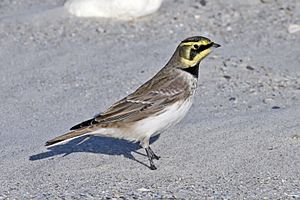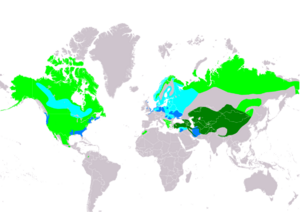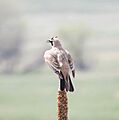Horned lark facts for kids
Quick facts for kids Horned lark |
|
|---|---|
 |
|
| Conservation status | |
| Scientific classification | |
| Genus: |
Eremophila (bird)
|
| Species: |
alpestris
|
| Subspecies | |
|
See text |
|
 |
|
| Distribution map of horned lark Breeding Resident Passage Non-breeding | |
| Synonyms | |
|
|
The horned lark or shore lark (Eremophila alpestris) is a small bird found across the northern parts of the world. It belongs to the lark family. People in North America call it the "horned lark." In Europe, it is known as the "shore lark."
Contents
About the Horned Lark's Name and History
The scientific name alpestris comes from Latin. It means "of the high mountains," like the Alps. This bird was first put into a different group of birds called Alauda.
Scientists believe the horned lark has been around for a very long time. Fossils of this bird have been found that are about 1 million years old. One amazing discovery was a 46,000-year-old frozen horned lark found in Russia in 2020!
Recent studies of the bird's genes suggest there might be different types of horned larks. Some scientists think these types could even become separate species one day. For example, some suggest splitting them into four main groups, like the Himalayan horned lark and the common horned lark.
Many Types of Horned Larks
There are many different kinds of horned larks, called subspecies. Scientists have identified 42 different ones! Each subspecies might look a little different or live in a specific area.
- The Northern American horned lark is found in eastern Canada.
- The Dusky horned lark lives on the western coast of Canada and the USA.
- The Shore lark (E. a. flava) is found in northern Europe and Asia.
- The Southern horned lark (E. a. penicillata) lives from Turkey to Iran.
What Does a Horned Lark Look Like?
The horned lark is easy to spot compared to other larks. It is mostly brownish-grey on top and light-colored underneath. Its face has a cool black and yellow pattern.
The tail of the horned lark is mostly black, especially the outer feathers. This black tail stands out when the bird is flying. Male horned larks in summer have special black "horns" on their heads. These horns give the bird its American name.
The horned lark is a medium-sized bird.
- Length: About 16 to 20 centimeters (6.3 to 7.9 inches)
- Weight: Around 28 to 48 grams (1.0 to 1.7 ounces)
- Wingspan: About 30 to 34 centimeters (11.8 to 13.4 inches)
Their calls are high-pitched and sound like tinkling bells. When they sing, they usually do it while flying high in the sky. Their song starts with a few short sounds, then goes into a warbling, rising trill.
Where Horned Larks Live and Their Homes
Horned larks live in many places around the world. You can find them across North America, from the far north to Mexico. They also live in northern Europe, Asia, and in the mountains of southeastern Europe. There's even a small group living on a plateau in Colombia.
Some horned larks stay in the same place all year, especially in warmer areas. But those living in the far north will fly south for the winter. This is called bird migration.
These birds love open spaces. In Europe and Asia, they live above the tree line in mountains or in very northern areas. In Europe, you might see them on flat areas near the seashore during winter. In North America, where there are fewer other larks, they can be found in many open places. This includes farms, grasslands, deserts, golf courses, and even airports!
Reproduction and Life Cycle
During spring, male horned larks protect their areas from other males. Females sometimes chase away other females too. To attract a female, the male sings while flying in circles above her. Then, he folds his wings and dives towards her, opening them just before he hits the ground.
The female chooses the nest spot in early spring. She finds a natural dip in the ground or digs a small hole with her beak and feet. She spends a few days getting the spot ready. Then, she builds her nest using fine grasses, cornstalks, and small roots. She lines it with soft materials like down, fur, or feathers. The nest is usually about 7 to 10 cm (3-4 inches) wide.
Interestingly, the female often adds a "doorstep" of small pebbles or dried plant material to one side of the nest. Scientists think this might help hide the dirt she dug out, making the nest harder to find.
Females usually lay 2 to 5 grey eggs with brown spots. Each egg is about 2.5 cm (1 inch) long. The eggs hatch in about 10 to 12 days. The baby birds, called nestlings, stay in the nest for 8 to 10 days. Both parents feed and protect the chicks. In warmer southern areas, a female might have 2 or 3 groups of babies a year. In the colder north, they usually have only one group.
Horned larks can change how they build their nests. This helps them deal with different weather and avoid predators. It shows how smart they are at surviving!
Horned Lark Conservation Status
Sadly, the number of horned larks is going down. This has been noticed by bird surveys in North America. In 2016, a plan for bird conservation called the horned lark a "Common Bird in Steep Decline."
There are several reasons why their numbers are dropping.
- Habitat loss: Their open habitats are disappearing due to farming chemicals and cities growing.
- Reforestation: Some open areas they like are turning into forests.
- Human activity: More people and buildings mean less space for them.
- Wind turbines: In open areas, horned larks are often hurt or killed by wind turbines.
Because of these concerns, one type of horned lark, the streaked horned lark, was listed as a threatened species in the USA in 2013. This means it needs special protection to help it survive.
Gallery
-
A male at the North Carolina Zoo in Asheboro, North Carolina, US
-
In British Columbia, Canada
-
A lark displaying its horns at the Rocky Mountain Arsenal National Wildlife Refuge
-
A nest with three chicks in the oil fields of Alberta, Canada
-
Horned lark in Ystad 2009.








